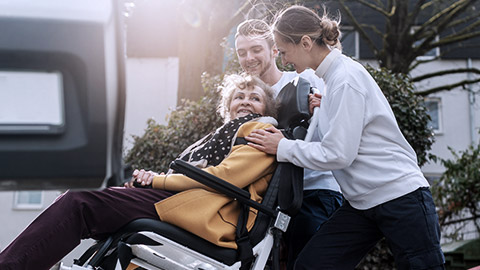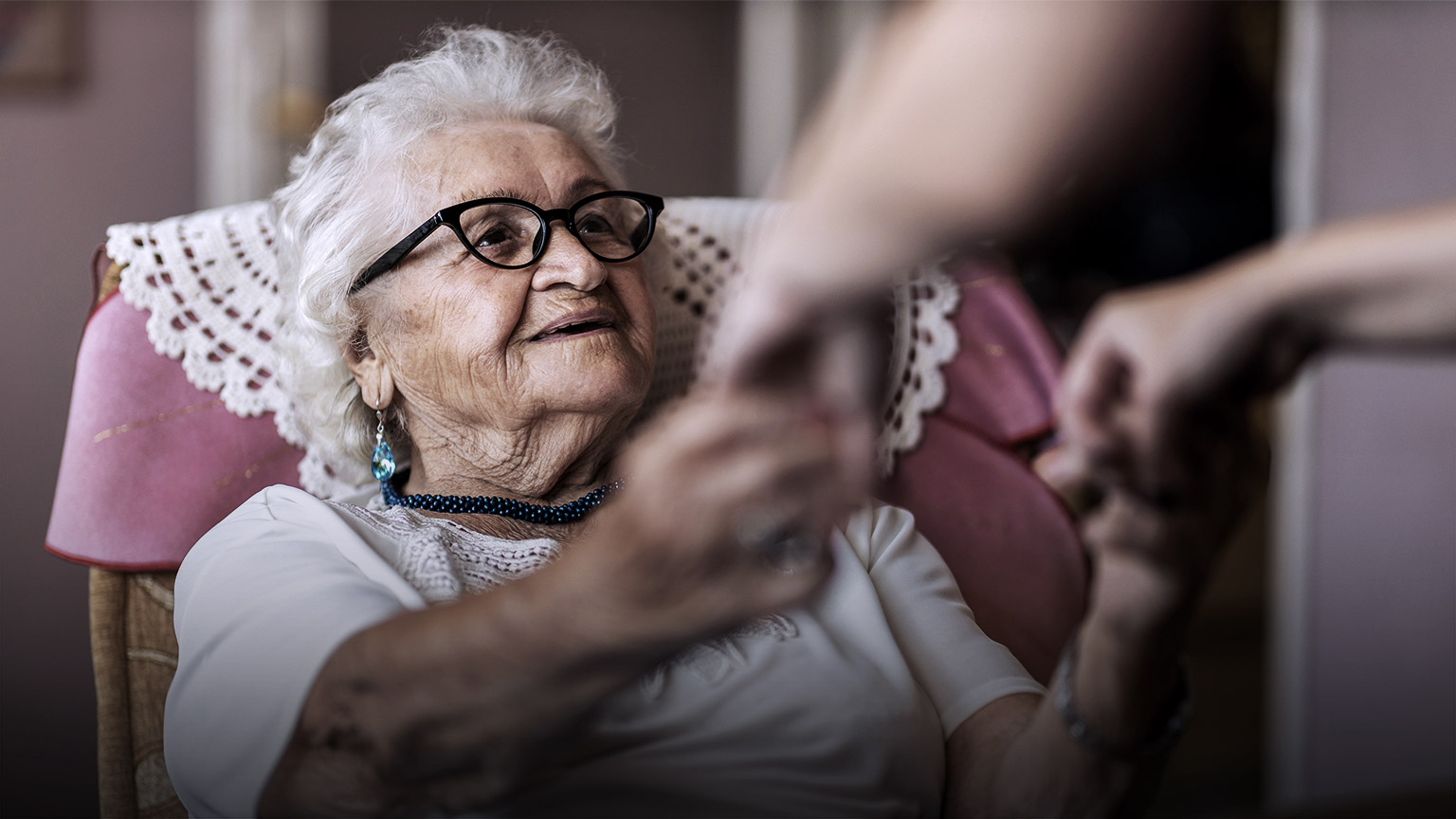The relationship between the care for the person in care, the carer and the family members do not remain static. Change can be a result of external factors or internal factors – accommodation might change; family dynamics change; relationships change; people change.
Change can occur for a variety of reasons:
- Moving to a new stage of life
- Family member composition alters
- New and different care support and approaches are identified
- The ability of the carer to continue to provide care
- The physical and emotional health of the person in care worsens or improves.
It is important as a support worker to be aware of any changes and be in a position to be able to mitigate any risks and:
- offer new or different kinds of support
- help carers and the person in care focus on the positive aspects of any transition.
Life transitions are periods in a person’s life where a change and/or adjustment occurs that impacts their life in a significant manner. It usually occurs between two relatively stable points in time in the person’s life (Schumacher 1999).
Every person experiences transition whether planned or unplanned, big or small. Transitions can involve exciting changes such as a new job or addition to a family. They can cause distress such as the loss of a loved one or a deterioration in their health (Womack 2021). Often these transitions will make us stop and re-examine the present sense of who we are.
Transition can affect emotional state and moods, ability to work or care for another person and social interactions.
The transition from one stage to another is not time-dependent nor occurs at any specific age. Each person may experience different transitions throughout their life. The transition from one stage to another is not without some risk to self or others who are a part of the transition.
Some common transitions include:
- Reaching a significant age - 30, 40, 50, 60 etc
- Getting married
- Becoming a parent
- Leaving educational institutions (university; school)
- Changing/losing a job/made redundant
- Becoming ill or disabled
- Experiencing bereavement
- Retiring.
Transition in late life
Life transitions for the aged may include:
- A family member moving from pre-caring to care
- Family member or friend taking on a caring role
- Engagement in formal service providers such as home care
- The person needing care enters into a day or overnight respite or moved from home to full-time, supported residential care
- People need care needing end-of-life or palliative care.
Life transition impacts positively or negatively on people’s lives:
| Positive | Negative |
|---|---|
|
Greater autonomy and control over life decisions and activities Increased financial and personal independence Sharing of responsibilities and tasks Improved self-esteem Satisfaction with a time of life and activities undertaking |
Less time for recreation as the focus is on others and earning a living Demands from other persons, family or work increases The cost of activities and lifestyle items increase There may be an increase in worry about others you are responsible for or relate to There may be an onset of depression, guilt, anxiety or distress immediately or on a daily basis after a death, incapacity or move A sense of self is often challenged and the questions asked ‘Who am I now?’ ‘Do I like who I have become?’ Disruptive behaviours may result when moved from familiar surroundings where cognitive functions are impaired Sense of loss and increased isolation when moved into a residential home as cut ties with the community |
Activity – Read
You might like to read a fact sheet about transitioning into aged care for family, friends and carers available from the Australian Centre for Grief and Bereavement website.
The fact sheet provides information about thoughts and emotions that arise when people have to adapt to a major life transition such as and older person transitioning into a residential aged care facility.
So, what might be some of the positive (healthy) or negative (unhealthy) processes of transition for the older person.

| Positive | Negative | |
|---|---|---|
| Redefining meaning of transition | The elderly person actively engages in exploring the transition with family, carer and friends and new meanings for the transition are discovered. The process to create meaning is complex and people need time to work through all the implications. | There is resistance by family, care and elderly person to the redefining meaning of transition. There is an attempt to use the old definitions to a new situation. |
| Modifying expectations | Expectations of what the elderly person has about themselves, their family and friends, the community and the future is often questioned during the transition. Previous expectations are modified and replaced with new, realistic expectations for the new situation. |
The elderly person and carer and/or family maintain previous expectations. They anticipate a future that is unrealistic and generally will not occur. |
| Restructuring life routines | Routines are restructured to suit the new situation and allow the elderly person to regain the sense their life is predictable and manageable They may even see the routine as to be enjoyed. |
The elderly person clings to old routines even if they do not work in the new situation. Where an environment does not have a sustained routine, the elderly person’s life may become unpredictable and disorganised resulting in feelings of loss and emptiness. |
| Developing new knowledge and skills | Over time the elderly person's knowledge and skills will closely mould to and fit the new situation. |
The elderly person ignores or avoids new knowledge and skills and the opportunities to develop new skills are not taken up. Current skills and knowledge are no longer applicable or useful for the new situation. |
| Continuities of some parts of life remain | Not all parts of the elderly person’s life or family changes. Whatever continuity can be maintained related to identity, relationships and environment is facilitated. | There is lack of awareness by elderly person and carer/family members of the possibility of continuity, and disruption occurs where it does not need to. Change that could be avoided occurs regardless of what is done. |
| Loss associated with transition | Although the elderly person may experience loss in some form, the gain is that there are opportunity for new choices. The elderly person is open to exploring these and/or seeking out and creating new experiences. | The elderly person or others in the environment limit the choices. This means the family and elderly person are passive to new opportunities and these are passed over without any exploration or discovery. |
| Finding opportunities for personal growth | The elderly person embraces growth and self awareness. Personal development is achieved and new relationships may be formed. | The elderly person rejects the opportunities for growth. The emergence of self does not occur. |
As a support worker, you will need to understand the concept of life transitions and how they positively or negatively affect the people you work with.
Activity – Case study and question
Case study

Simone has lived in her house with her husband and children since she was married. Her husband died of a heart attack in his 60s. Since then, she has looked after herself in the house. At 92, she has become very frail and has had the odd fall, although nothing has been broken.
The family has arranged for you as a support worker to provide care for Simone on a daily basis as her family do not want her to go into residential care. They believe as she has a pendant alarm and one of the family visits her at least once a day she is fine. They think they should and can look after her needs.
The arrangement is you come to the house in the morning, spend about an hour there and then return just after the evening meal to settle her into bedtime routine. Sometimes the family visits at the same time and Simone is left on her own for long periods of time. Simone has confided in you she is a bit afraid of living alone.
Question
What are the emotional reactions of the carers (family members) and the person needing care in this situation?
What might you do to transition Simone to the next phase of her life and help the carers and Simone to adapt?
Post your response online or discuss with your trainer or colleague
The nature of the care relationship between the person needing care and the carer or family member can be based on the reasons they are involved with the care:
- Practicality - They believe they are the best to provide care, have the appropriate skills and time out of those people available to provide care
- Moral duty - They have a duty to the person needing care or see it as the right thing to do in the circumstances
- Natural extension - Care is undertaken as a natural extension of the previous relationship with the person. It seen as a privelege and out of love not as an imposed duty.
Sometimes, the relationship between the carer and the person receiving care changes. This may be as a result of the capacity of the carer to provide care and support. The carer may:
- not be able to look after the person in short term or long term as a result of experiencing emotional or physical illness themselves
- experience changes in relationships with other family members such as divorce, a child leaving home, additions to the family
- have other family commitments such as child trauma (diagnosed with a medical issue needing dedicated care or an operation)
- have a career change they wish to pursue requiring different housing or living location
- experience financial difficulties.
These circumstances may necessitate some additional short-term support or longer-term consideration of alternative care arrangements for the person needing care.
Depending on the nature of the care provided by the carer, you as a support worker or the carer may need to: • undertake personal things with the person in the care you have not previously needed to do which may be uncomfortable or embarrassing for both parties in the first instance • spend more time with the person in care than before to meet their changed needs
The positive and negative effect of change in carer relationships
The change in the needs of the person and what has to be done to meet these needs can have a positive or negative effect on the carer, the family members and the person being cared for. It may change the perception of how the carer, family members or person in care see each other and change the relationship dynamic. The carer, family member or person in care may experience:
- feelings of loss
- uncertainty as to what the future might hold
- uncertainty about the skills the carer may have or need to have and learn
- additional stress
- fear of the unknown or change
- feelings of being useless
- feelings of being controlled by other persons and losing independence
- frustration in managing personality changes in the person they are caring for
As a support worker, you need to be alert to any changes in carer and person they care for the relationship.

Change in caring relationships and transition to different situations or circumstances does not come without risk.
Any changes in relationships can result in either physical or psychological (or both) risk of harm to the person receiving care and support as well as the carer.
Sometimes it can lead to conflict in relationships with family as change means the weight of responsibility might now lie with one family member, and not spread across the family members. This can lead a carer feeling overwhelmed with the responsibility or not feeling able to have the skills or knowledge to manage the care.
Risks of change and transition may include:
| Change | Explanation | Risk |
|---|---|---|
| Loss of support | Support is important to the carer, family members and person needing care | Withdrawal of support may mean loss of such things as funding, guidance, education and training essential to care that cannot be replaced. Carer and family members lifestyle choices and activities may have to be sacrificed to provide necessary care for person in need. |
| High level and intensity of care | An increase in the intensity of care can in turn increase the burden on the carer or family member. |
Lead to stress and/or resentment towards person caring for Blame person for difficulty in providing care and the things they have to do to support them |
| Conflict with service providers | Carer and/or family members may not agree with type of service being offered the person needing care | If the relationship between service providers, carers and person in need of care breaks down, the ability to implement strength based approaches will break down |
| Conflict with family members | Family members and carer do not see eye to eye regarding care for the person in need |
Emotional distress from person in care observing family dynamics Depression, blame and anger in carer or family member passed on to person needing care when undertaking care duties |
| Level of carer stress increases | Caring can be difficult and time consuming. Stress can build up over time | Tension between all people involved increases leading to arguments and disagreements about daily life and relationship Stress can harm the carer relationship with person needing care and in worse case scenarios lead to abuse |
| Carer health | Decline in carer health or new physical or emotional illness diagnosed may mean change in care or support e.g. move to residential care facility | May limit the ability of carer to provide same level of care to person as they previously have or stop care altogether Responsibilities may need to be realigned among carer and family members which in turn will affect how family member perceives carer and person needing care |
| Role in family dynamics | Carer may have change in role where they are required to care for more than one dependent person | Difficult to prioritise care for each person needing help Difficult to provide sufficient and effective services to meet demands of all persons in need |
| Personality and behaviour of person needing care | Personality and behaviour of person needing care changes as a result of change to physical or mental health. |
Carer and family member may not be able to cope with changes leading to emotional outbursts, arguments and possible abuse Person may need additional level of support requiring move to full time residential care which in turn may affect the carer and family members’ emotional state. |
To best support the carer, family members and person in need during times of change, you as a support worker may need to:
- Discuss the changes with the carer, family members and person in care to facilitate ongoing arrangements
- Suggest ways of dealing with the changes such as personality changes in the person needing care. Carers and family members may find it hard not to argue, yell or work with the person if they have a personality change as a result of illness or additional physical needs. You might suggest it is more effective to take the emotional attachment out of the tasks and complete them more in line with a professional care worker
- Take over some of the care duties and responsibilities or arrange for these to be supported by other service providers
- Defer to your coordinator for advice on how to provide appropriate support to the current caring arrangements.
Positive effects of change
There are also positive effects of the change in care circumstances. The carer, family member or person needing care may:
- Increase their self-confidence and self-esteem at meeting new challenges or the changes
- Feel energised and excited about different things they will experience
- Feel additional closeness and intimacy and create a bond that may have been previously missing.

Our personal experiences give us some indication of how change and transition to another period of our life can feel. This gives you the opportunity to be able to empathise with carers, family members and the person needing care during their periods of change and transition.
Change and transition is not easy for the carer, the family members and the person who may be in care or going to be cared for. It can be confronting and challenging especially when other factors are in the mix such as:
- Planning for complex needs for the person in care
- Managing financial issues to ensure adequate and appropriate emotional, mental and physical support is provided
- Change occurs in a short period of time or suddenly not allowing the carer, family members or person needing care to absorb the change and work through it.
Keep in mind that it is not only the person who is being cared for that needs reassurance. The change to caring circumstances will also affect the carer and the family members – these people need feel they are actively involved in the change and transition, have control over their own lives during this time and can make decisions on how they will, and want to be involved.
Service delivery frameworks, philosophy and models
There are many different models and philosophies surrounding the care of people, including those entering the later years of life.
Some of these are explained here.
| Explanation | Example | Support worker interactions with carer and person being cared for | |
|---|---|---|---|
| Service or system-centred approach (traditional approach) |
This model is based on talking about the person and doing all the planning for them. It is focused on diagnoses, deficits and labelling persons. The way in which services are delivered to the person in need is based on what works best for the staff and the organisation. Staff are the experts and their professional judgement is used to determine the best approach The authority and power is held by the professionals |
Problem-focused with support activities created and based on what works for people who have ‘that particular diagnosis or disease’ A treatment plan is often devised before even meeting the people it will be implemented for. |
Little interaction occurs other than to be informed of the type of care and support that will be provided. Family members and carers are seen as peripheral and their input is not valued |
Activity
Watch the video and read the article to find out more about the differences between the strength-based approach and the traditional system-based approach to care.
Watch
Watch Beth Mount Person Centered vs System Centered
| Explanation | Example | Support worker interactions with carer and person being cared for | |
|---|---|---|---|
| Person centred approach |
The professional knowledge of medical staff and carers knowledge is combined with the person needing care’s knowledge of their own values, feelings, body and capabilities The person under care is at the centre of every decision or action The person under care is an individual and unique with their own personal values, boundaries, beliefs and perspectives The person’s needs and preferences in how they like to live their life are respected The person’s knowledge they bring about their emotional and physical health and wellbeing is valued. If a person cannot share what they need, carers often can The person is treated with dignity, compassion and respect |
Given a choice of what to eat at meal times Deciding on the clothes to wear for a shopping trip or for the day Understanding their life experiences, present state and what goals they might want to meet in the future |
Smile often Wear name tag that can be seen Ask how carer, family member, person needing care is feeling on the day (emotionally and physically) Actively listen to the person under care, the carers and family members
Make sure the people involved have all the information needed to make informed choices |
Activity
Read more about a person-centred approach from the following articles and fact sheet
NSW Health. What is a person led approach?
NDP. Factsheet What is a person-centred approach
| Explanation | Example | Support worker interactions with carer and person being cared for | |
|---|---|---|---|
| Strengths-based approach |
A collaborative process between the person needing the care and the carer, family members and support workers supporting them A holistic approach to well-being drawing on strengths of carer, family, person in care, communities Acknowledges each person has a unique set of challenges and strengths All people work together to determine outcomes that draw on the person needing care’s strengths and knowledge of self Older people can manage change in a positive manner with support from carers, family members, support workers, medical professionals, care networks |
Solution focused approach person encouraged to set goals before identifying strengths Strengths-based approach a strength assessment is carried out before goals set |
Focus on the strengths of person needing care and cares not deficits to counteract any difficulties Enable links to resources such as institutions, groups, and associations that have something to give to the carer, family member or person needing care Support worker explains choices to carers, family members and the person under the care and encourages people under care to make their own decisions and informed choices |
Activity – Read
Read more about strategies to implement strength-based approaches to care from the following articles
Kate Pascale and Associates. 2019. Embedding a strengths-based approach in client conversations.
| Explanation | Example | Support worker interactions with carer and person being cared for | |
|---|---|---|---|
| Active support |
A person-centred approach that encompasses: actively engaged each day whenever an opportunity consistently approaches are structured and predictable enough so the person experiences comfort, continuity and a better ability to engage engaged to be doing things, making decisions, spending time with others, making choices a meaningful increase in competence and opportunity; stay connected socially to others; improve self-esteem by focusing on the needs, preferences and goals of the person |
Choose own clothes Choose what you want for breakfast |
Carers and support workers work with them rather than helping them Seek out chances for a person in care to express their wish for relationships an activities Ensure activities recommended are for the sake of engagement not just the sake of an activity Activities must be meaningful to the person All persons are included regardless of support needs Commitment to make it happen from a person in care, carers and support worker Involves listening, thinking together, coaching, sharing ideas, seeking feedback Aim to understand what person in care wants and needs to live own life, personally defined |
Activity – Watch and read
Watch a video and read more about active support strategies in action.
Watch
Watch NSW Government. Active support – A day in Fran’s life
Read
Active support in action from Aruma, Our person-centred approach and active support.
Jones, E., Perry, J., Lowe, K., Allen, D., Toogood, S. and Felce, D. Active Support, ARC Cymru.
Strategies to support carer, family and person in need of care
Frameworks, philosophies and models help inform the strategies that can be applied to support the carer, family and person needing care in routine visits, or times of change and transition.
There are a number of strategies that can be used to try to make the transition to care or more complex care less unsettling and more positive.
| Strategies | How does this strategy help and support the carer, family member and person needing care |
|---|---|
| Acknowledge anxiety |
Carers, family members and the person needing care should not have to hide they are anxious about the change. Recognise and confirm they have the right to feel anxious and have some fear or trepidation about the unknown future and what it holds. Respect, accept and support the way and mechanisms they use to handle their anxiety. |
| Support systems are maximised |
Change and transition can mean more people are or will be involved in the person’s care and support. This opens up a variety of strengths, abilities, knowledge, skills to ensure the person needing care has a structure in which they receive the best quality of care. |
| Look for opportunities for active involvement |
Change and transition to the next phase in a person’s life can provide the opportunity for family members or carers to be actively involved in their support. Consider in consultation with the carer, family members or person being cared for/or going to be cared for, how they can contribute or participate. Don’t just dictate or put your own personal views as the only way to move forward. This can be very off putting and you may find there is not much co-operation or building on relationships between the people involved. |
| Reassure the carer, family members and the person needing care |
Reassuring the carer, family members and person needing care that their decisions about how to cope with changes and transition in their life is the best choice for them is important. Change and transition brings with it a certain amount of uncertainty, even if the people involved are excited or looking forward to the change. |
Strategies should be selected keeping in mind:
- the current situation
- the specific needs of the person in need, the carer and the family members at the time
- the identified ongoing needs of the person needing care as a mental or physical illness deteriorate if this is what has caused the change in care
- the characteristics of the carer, family members and person needing care
- the wants and desires of the person needing care, the carer and family members
- the cognitive and physical needs of the person requiring care
- any cultural or linguistic issues.
Another strategy to use to maximise a positive transition to the next stage of life for the person needing care, the carer and the family members is to follow a number of steps to an end result.
Any strategies and actions should be agreed to before being implemented by:
- the carer
- family members (where appropriate) and
- person needing care (if able)
As a support worker the strategies you employ should focus on promoting positive and respectful relationships with the carer, family members and the person needing care.
You will need to approach each situation or circumstance in a different way – each carer, family member and person needing care is different. No two situations will be totally the same, so no two strategies will be the same either.
Activity – Discussion
Discuss with a colleague or your trainer the strategy you might use when working with an elderly carer from an Aboriginal background who is looking after a friend of around the same age, compared to working with a carer who is mid 30s, holds down a high powered job and is looking after her mother who has early onset of dementia.
Part of your role as support worker is to:
- Identify and help address the risks associated with change
- Identify the positive aspects of change
- Support the carer, family members and person in need of care to use strategies to manage the change.
Activity – Case study and discussion
Case Study

You are a support worker providing respite to Alia who is in her mid-40s. Alia has become a carer for her father since the death of her mother some years ago and is afraid of losing her father as well. She has no other relatives. Alia’s father has a disability affecting his mobility and that confines him to an electric chair. Alia worries about him constantly. She does everything for him despite him protesting he is able to do some things for himself.
In discussion with Alia and her father, an arrangement has been made for you as support worker to stay with him in his home for 3 hours at a time, twice a week to enable Alia to go to her own appointments and have some ‘me’ time.
Alia constantly worries about her father and does not like leaving him with you (or anyone else) during this time. She often comes back to the house early with poor excuses or leaves late so her father is not alone with you.
Alia constantly gives you instructions for her father and tells you what her father likes and dislikes.
Question
How will you work with the carer (Alia) and person needing care so that the carer can enjoy the respite time she is provided?
Post your response online or discuss your thoughts with your trainer or colleague to the question.
We aim today to be able to keep a person in their own home as long as possible.
Carers, friends and the family of the person needing care often provide significant support in terms of emotional, physical and social assistance. They may also provide advice on decisions that need to be made.
There are a range of support services for the carer, family members and the person requiring care to enable them to remain in their own home as long as possible. These types of support mean the relationship between carer, family members and person needing care can be more easily maintained. The person in care is able to live an active life and enjoy participation in activities within their own community and environment.
Support mechanisms to do this include:
Remember as a support worker you should not be taking over and telling the carer, a person needing care or family members what support they need. Your role is to:
- complement them
- work together to identify the support needs
- agree on support needs that will benefit the person requiring care.
In preparation for asking the question of the carers, family members and person requiring care what it is that they need in terms of support you might consider:
- How the carer, family member or friends currently support the person needing care
- What role or part do they play in the person’s life – mentor, friend, physical comfort, emotional support; listener; day-to-day personal things like bathing, cleaning, preparing meals
- The skills, knowledge and experiences they can offer to enhance and maximise support
- The skills, knowledge and experiences you as a support worker can offer to maximise support
- Ways in which you might investigate so that any support you can find can be maximised to the benefit of the person requiring the care
- The way in which you will work with the carer, family members and person needing the care to ensure care and support is maximised, ensure the comfort of the person needing care and support all persons involved in the day-to-day life of the person being cared for
They can tell then tell you their requirements and you can look to maximise through service providers and government organisations and funding to get the support they have requested.
Activity – case study and question
Case study

Hilda is in the early stages of dementia, and she has been independent with her own personal care for the time that she has lived in the retirement village. She showers herself each morning, and the plan reflects this. She has two support workers – Noeline who comes in for the morning care and Yusef who attends at night to check Hilda is eating her evening meal and needs no further support. Noeline helps her get ready to shower, setting out towels, soap, and clean clothing of her choice, but Hilda does the rest. Recently, the support worker noticed Hilda has a persistent odour.
Hilda has also complained of a rash under her breasts to both support workers. Yusef has concerns that Hilda can no longer attend to her own personal hygiene needs well.
Yusef lets his coordinator know about these concerns and writes down in Hilda’s file what he has noticed. He also adds the information in the communication book left at Hilda’s home for the family to read. Hilda’s family life away from her and one of them will usually visits at least once every three weeks.
The coordinator, Yusef and Noeline come up with a plan. Yusef suggests Noeline have a talk with Hilda about her showers. The coordinator also suggests Yusef and Noeline make time to speak with the family about the level of dementia and further care Hilda may need.
Noeline asks her if she feels that she needs any further help. Hilda says no. She looks at Noeline with a worried look on her face.
Question
What actions might you come up with to maximise the support Hilda needs to meet her showering needs as her dementia gets worse?
Post your thoughts online or discuss them with your trainer or colleagues.

